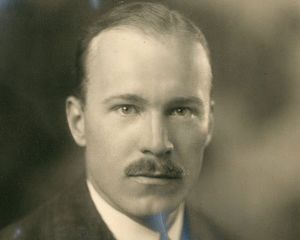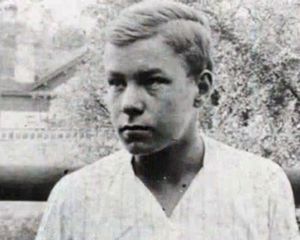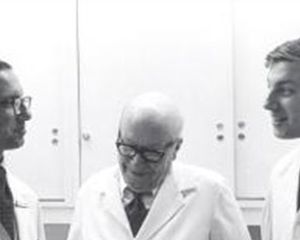Algernon B. Reese, MD, dominated the world of ophthalmology in the 20th century, but his legacy last’s in the 21st century.
Dr. Reese believed in staying busy, working hard, always perfecting whatever he did, sharing thoughts and experience and being open always to new ideas and approaches. When he died at age 85 in 1981, everyone in ophthalmology knew him (or of him). His obituary in The New York Times emphasized his contributions, career and some of his most famous patients (no HIPAA then), including actors John Wayne, Bob Hope and Paul Muni; Chinese leader Chiang Kai-shek; Edward VIII and Wallis Simpson, the Duke and Duchess of Windsor; baseball legend Babe Ruth; composer George Gershwin and novelist Ernest Hemingway.

Portrait of Dr. Algernon B. Reese, circa mid-1930’s. Reproduced
with permission granted by the Historical Society of Western Virginia.
In some ways, Dr. Reese's life was planned for him, but despite the planning, it didn’t go exactly as envisioned. He was born and raised in North Carolina where his father was a pharmacist. His uncle, Robert G. Reese, MD, was an ophthalmologist in New York. Algernon always wanted to be a physician but lacked the money for medical school so his family made a “deal” with his uncle: His uncle would loan them money for the cost of medical school in return for Dr. Reese joining him in practice in New York when he completed training.
After graduating from Davidson College in North Carolina in 1917 and Harvard Medical School in 1921, he did a surgical internship at the Roosevelt Hospital in New York (1922-23) followed by a residency at the New York Eye and Ear Infirmary in 1924-25.
In those days, the science of ophthalmology was pathology. Dr. Reese had developed an interest in pathology (his uncle’s plan had included studying pathology with the “greats”) so he spent six months in Boston with Verhoeff, followed by a year with Ernst Fuchs in Vienna, where he received a degree from the University of Vienna. In the fall of 1926 he returned to New York as planned, where he joined the private practice of his uncle, but the plans soon fell apart.

Algernon B. Reese knew from a young age that he wanted to be a physician.
Image and permission to reproduce provided by Algernon B. Reese III.
In October 1926, just months after starting, his Uncle Robert, then 61, died unexpectedly. Dr. Reese took over the busy Manhattan practice. He was adept at running the practice and from then on, according to one of his later associates, he never stopped. For the rest of his professional life he merged a private midtown practice with hospital appointments/obligations/titles and a very active surgical practice, all while doing his own pathology. He joined the New York Eye and Ear Infirmary, serving as chief of clinic and pathologist until 1932. He then joined the staff at Columbia for a year, then resigned to become chief of the eye clinic at Cornell, where he became associated with Memorial Hospital, now Memorial Sloan Kettering Cancer Center.
At Memorial he met the head and neck surgeon, Hayes Martin, MD, and together they began exploring the use of radiation for retinoblastoma. Radiation had been first reported to work in retinoblastoma treatment about 30 years earlier, but techniques were crude and there were no physics to help gauge the dose to deliver. Often, dosage was determined only by “skin tolerance.”
At the time, radiation sources and energy gave a higher dose to the skin than to the eye and had a large penumbra, causing significant local toxicity. Although some patients were cured, few eyes survived and even fewer survived with vision. With Dr. Hayes Martin, Dr. Reese learned how to modify the beam and aim it to lessen toxicity to structures, and to measure dose, improving success rates for saving eyes, eyesight and for a few — restoration to normal vision. Drs. Reese and Martin not only performed the radiation treatments themselves, often they also served as anesthesiologists for their pediatric patients.
In 1931, Dr. Reese resigned from the New York Eye and Ear Infirmary and Cornell positions to begin a lifelong association with Columbia University College of Physicians and Surgeons and the Eye Institute, where he rose to professor of ophthalmology and director of eye pathology. At Columbia he established the first clinic dedicated to retinoblastoma and each week in a basement room, he would examine children under anesthesia.
Dr. Reese's fame grew. Patients and visiting physicians came, he soon realized how difficult it was for families to come and stay in New York for exams and treatment. At his own expense, he purchased a townhouse near the hospital, where families could stay while in New York. The families were never charged for lodging, and his friends would clean and maintain the townhouse.
He would split his time between his private office and Columbia Presbyterian where he did his retinoblastoma work. While he was a true pioneer, he was always open to new ideas.
It must be remembered that Dr. Reese did almost all of his melanoma and retinoblastoma work with the direct ophthalmoscope in a time when there was no ophthalmic photography. At Columbia, he worked with a medical illustrator, Emil “Gus” Bethke, whom he taught how to use the slit lamp, gonioscope and ophthalmoscope. Bethke documented many of Dr. Reese’s cases and his illustrations fill his famous textbook on tumors. Later, I had the opportunity to appreciate how accurate these drawings were.

Pictured from left to right: Dr. Ellsworth, Dr. Reese and Dr. Abramson.
Image source and permission to reproduce by author, David H. Abramson, MD, FACS.
While writing a treatise on retinoblastoma, I came across the record of a patient whose retinoblastoma had been successfully treated with diathermy by Charles Perera, MD, and illustrated by Bethke. I examined that patient 50 years after his previous treatment and — using modern ophthalmic imaging — I was able to photograph the eye and ora seratta. When I compared my photos with Bethke's illustrations 50 years later, I realized that he had depicted the ora precisely as it was … not as the usual "sawtooth" filled in by most other illustrators.
Even though Dr. Reese had great confidence in his skills, knowledge and abilities, he was always open to new things. For example, he immediately realized the benefits of the newly designed indirect ophthalmoscope. Dr. Reese was in his 60’s when it became popular in the U.S., he quickly learned and perfected its use.
Columbia’s mandatory retirement age of 65 for surgery required Dr. Reese to cease performing surgery in 1962. I entered the Eye Institute in 1970. In those days the entering residents began the residency in a rotating fashion: each on four months after the other. I was assigned the extra year. Fortunately, D. Jackson Coleman, MD, kindly invited me to join his pioneering work on ultrasound for a year.
Dr. Coleman encouraged me to explore what was afoot in the Eye Institute, and I met, Robert M. Ellsworth, MD, who was pursuing Dr. Reese's retinoblastoma work. One day, I walked past an open, unmarked door. There — stooped over a microscope — was an older man. He said he was working on a book.
"It's about tumors of the eye," he said. He was searching slides for material to use for the third and final edition of his legendary book, to which I still refer, "Tumors of the Eye." I told him about our work with ultrasound in the diagnosis of ocular tumors.
"Would you like to write a chapter for my book?” he asked. I was stunned! He did not know me nor anything about ultrasound, but immediately recognized ultrasound's potential value to the work.
"I don’t know anything about tumors,” I said.
To which he replied: "You’ll learn!”
He taught me about tumors and I taught him about ultrasound. When his book was finally published, I was shocked that he acknowledged me for my contribution to his book.
Dr. Reese received many honors and awards in our field and lectured extensively. He always worked to make organizations better and to help his fellow physicians. He was a charter member of the Verhoeff Society, president of the American Academy of Ophthalmology and Otolaryngology in 1955, chairman of the AMA Section of Ophthalmology in 1966-67, president of the American Ophthalmological Society (AOS) in 1960 and chairman of the American Board of Ophthalmology in 1960.
He sponsored countless American and international fellows, published more than 200 peer reviewed papers and published his first book, "Tumors of the Eye” in 1951. Dr. Reese never sat on his laurels. He revised and republished the book again in 1963 and the last edition — the one to which I contributed — in 1977.
Although Dr. Reese is best remembered for his work on uveal melanoma and retinoblastoma, he was a prolific surgeon who had extensive experience with surface ocular malignancies, periocular malignancies, orbital tumors and a fascination with PHPV (PFV). Interestingly his AOS thesis was "Peripapillary Detachment of the Retina Accompanying Papilledema.” His Jackson Lecture was on PHPV.
Prior to the use of radiation for retinoblastoma, the standard practice was to remove almost all eyes with retinoblastoma including bilateral enucleations. For most of the 20th century, the only way to save an eye with advanced disease (and vitreous seeds) was radiation. Children’s lives were saved, eyes were saved and vision was often saved. In fact, retinoblastoma is the only solid tumor of childhood that can be cured with radiation alone!
Dr. Reese had perfected the techniques, established the dose, fractionation and portals and delivered some of it himself, but in 1955 he reported that — years after treatment — two of his patients had developed fatal cancers in the radiation field. In 1972, he and Bob Ellsworth, MD, encouraged me to spend time at the Armed Forces Institute of Pathology (AFIP), with Lorenz Zimmerman, MD, exploring these curious second cancers.
As a result, we realized that children with retinoblastoma had a genetic defect (this was more than 10 years before the gene was sequenced), which made them prone to developing subsequent cancers (we called “second cancers”). We also identified the exquisite sensitivity these children experienced to the harmful effects of radiation. In effect, we showed that radiation was a double-edged sword and that more children were dying from the second cancers than from the retinoblastoma itself. Reese immediately appreciated the dire consequences of radiation.
There was a nonophthalmic side to Dr. Reese, too. In college he played basketball and was the team captain. Throughout his life he enjoyed tennis, hiking and water sports. In his later years he took up golf with enthusiasm and used home movies to help his swing.
Perhaps because of his time spent in Europe he appreciated good food, wine, dancing — and then there was bridge! He loved bridge, read books on it, studied it and played regularly. He hosted parties for the staff at the Eye Institute and included a yearly golf tournament. He was a southern gentleman who never cursed, never boasted, was polite and respectful of all people.
And yes, he completely repaid his uncle's widow for the loan he received for medical school.
I stand on the shoulders of this giant who made me look taller.